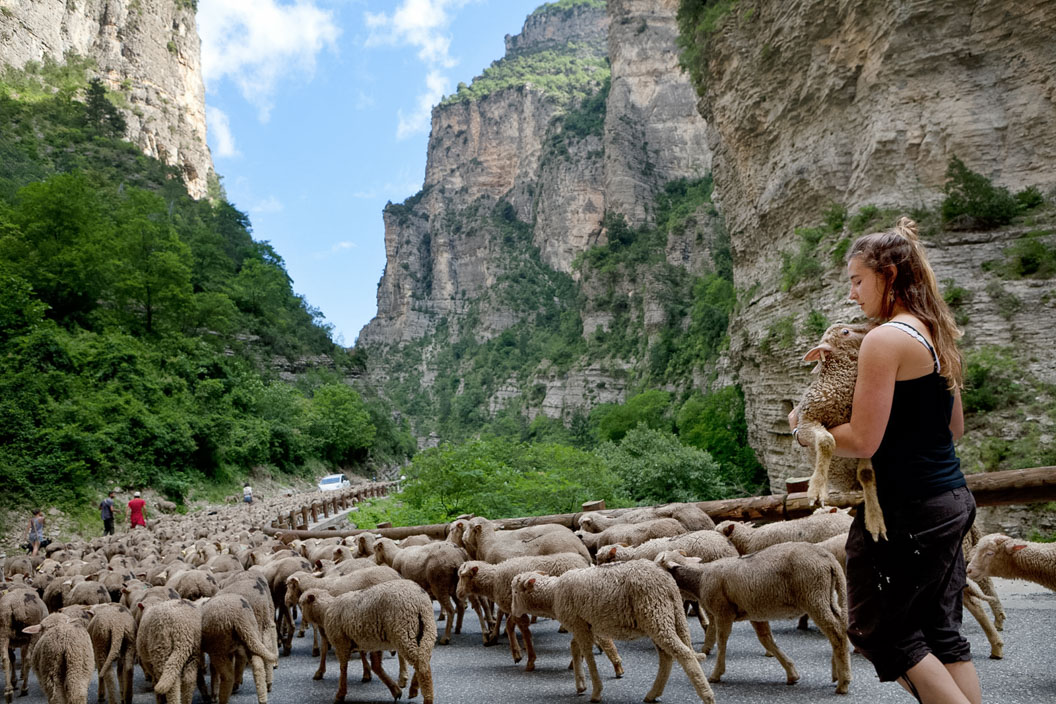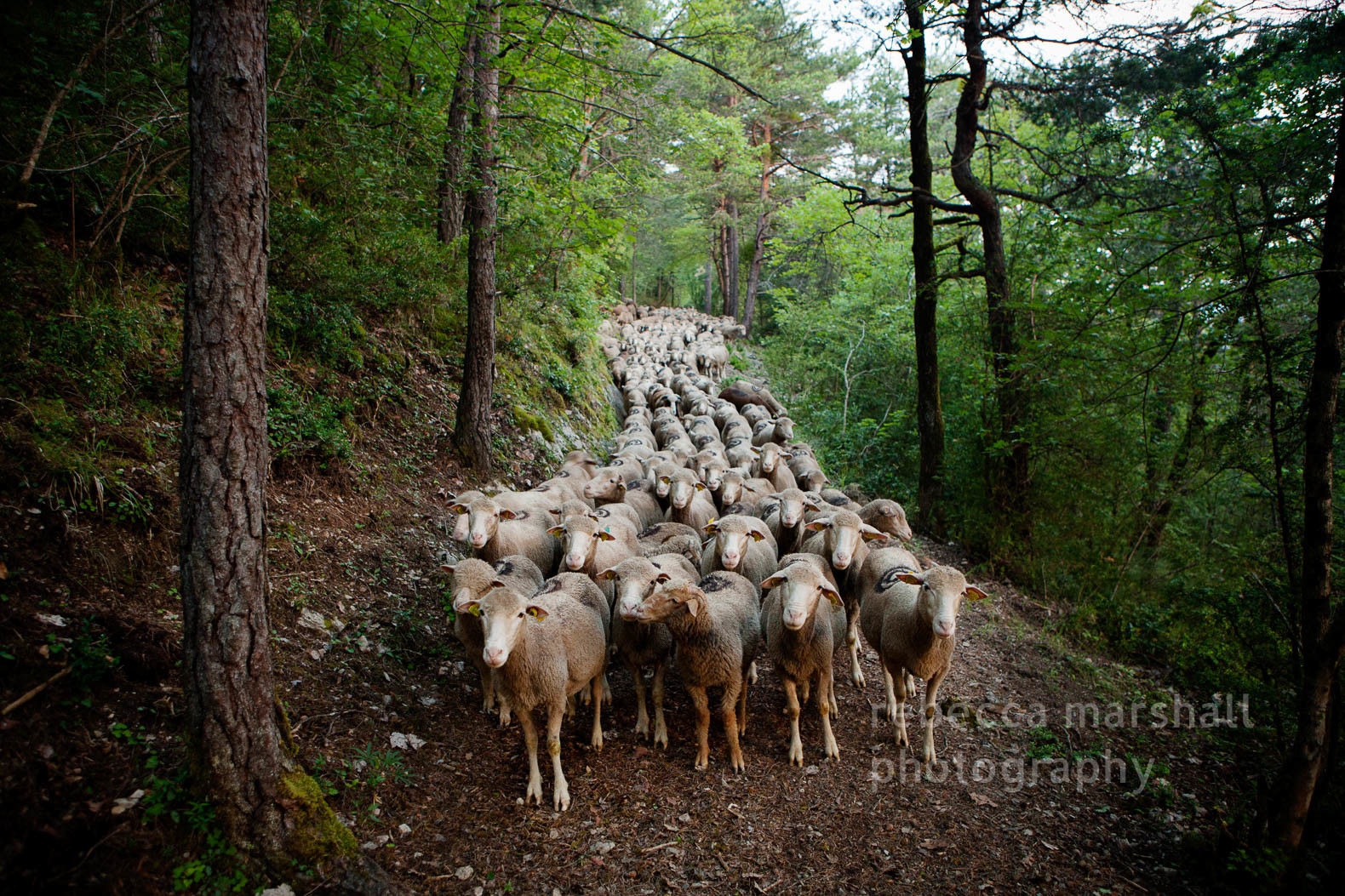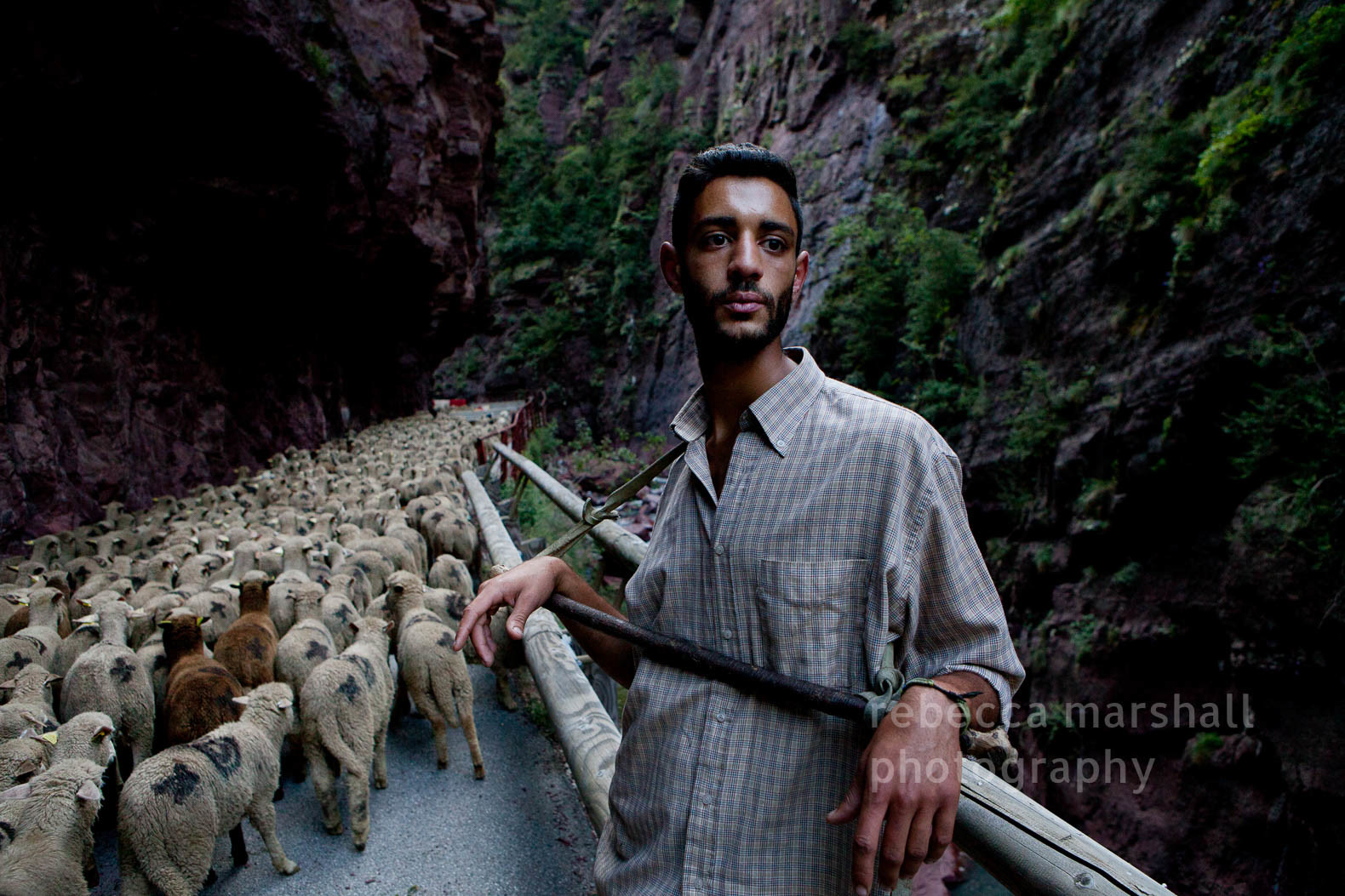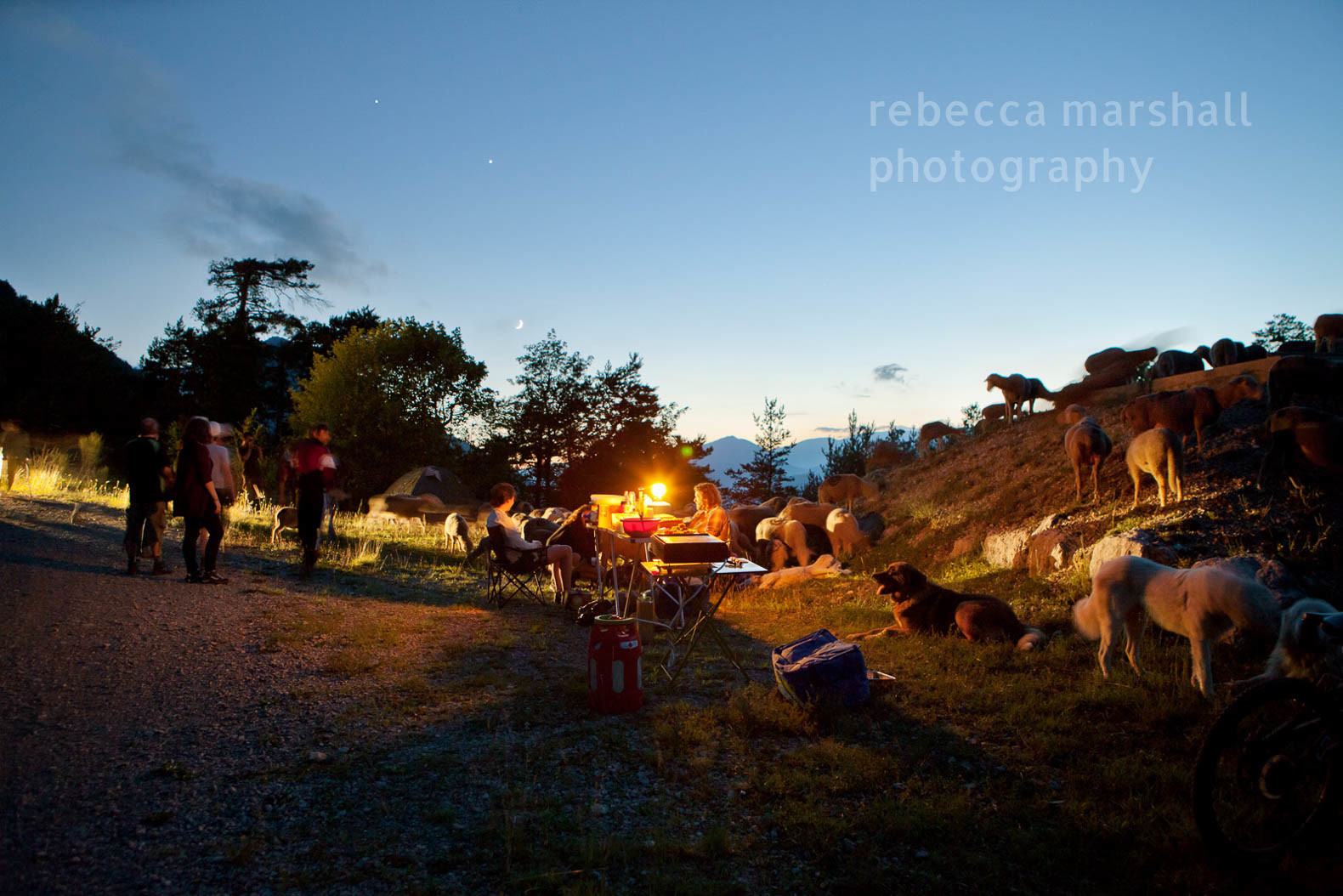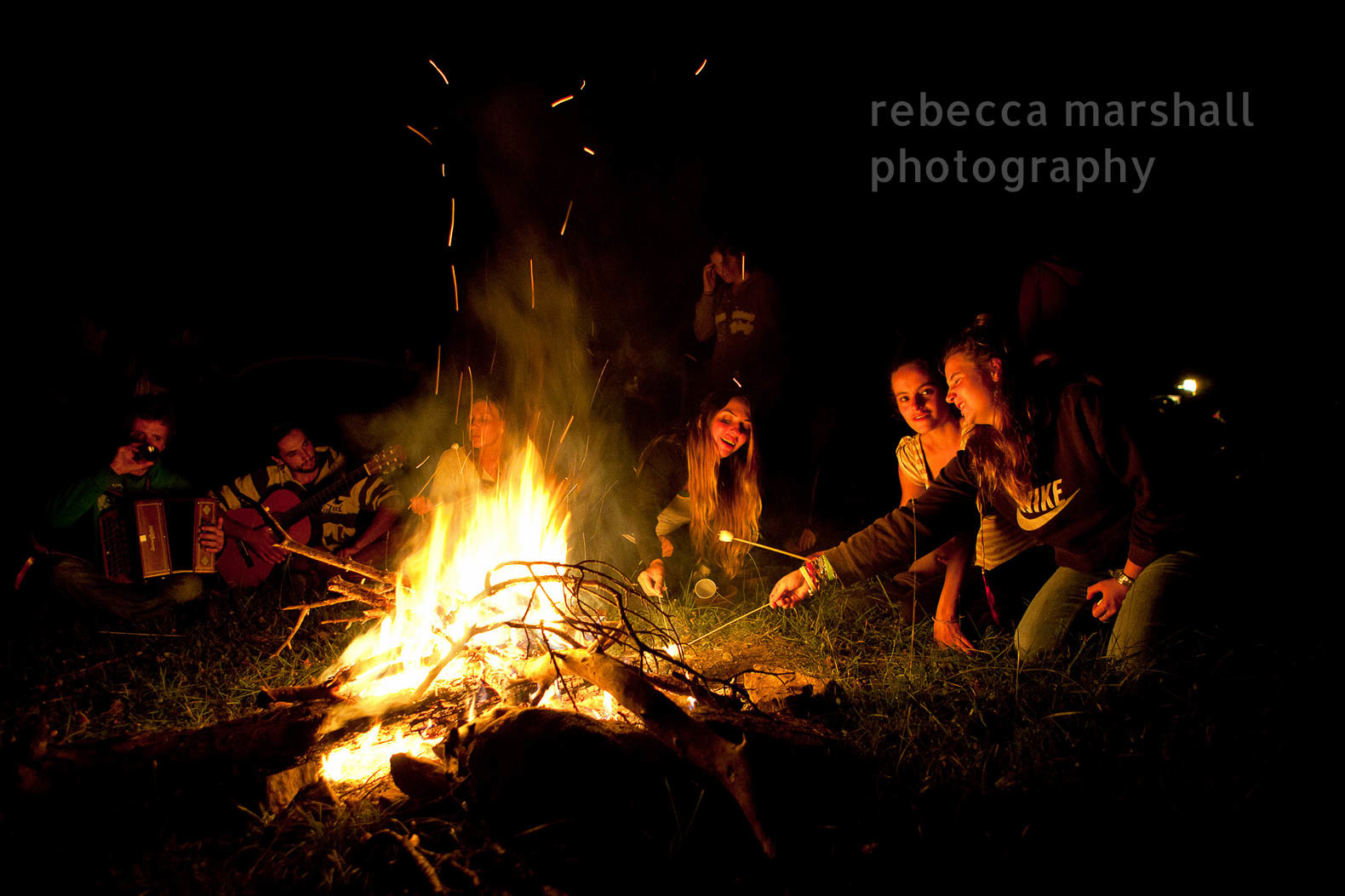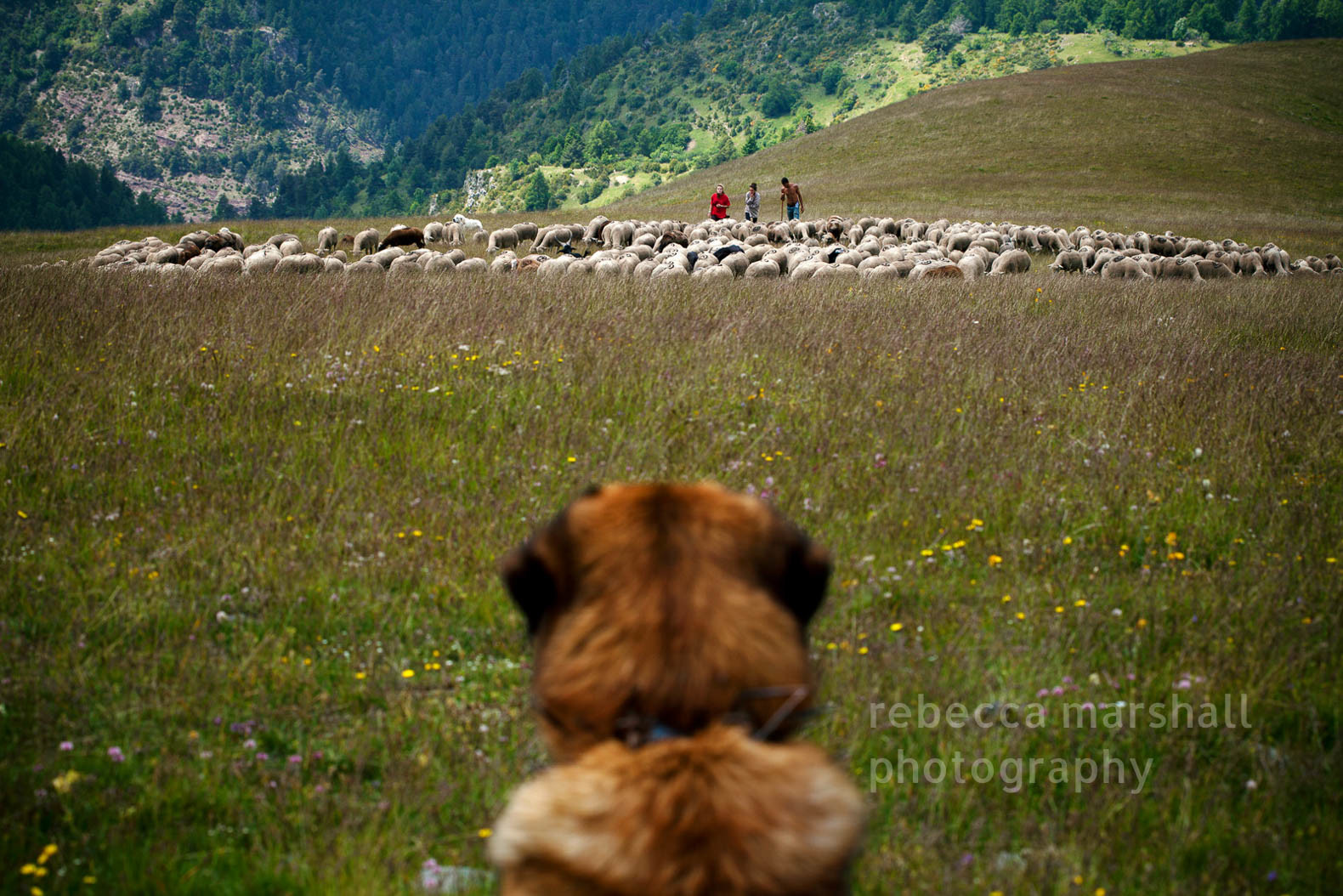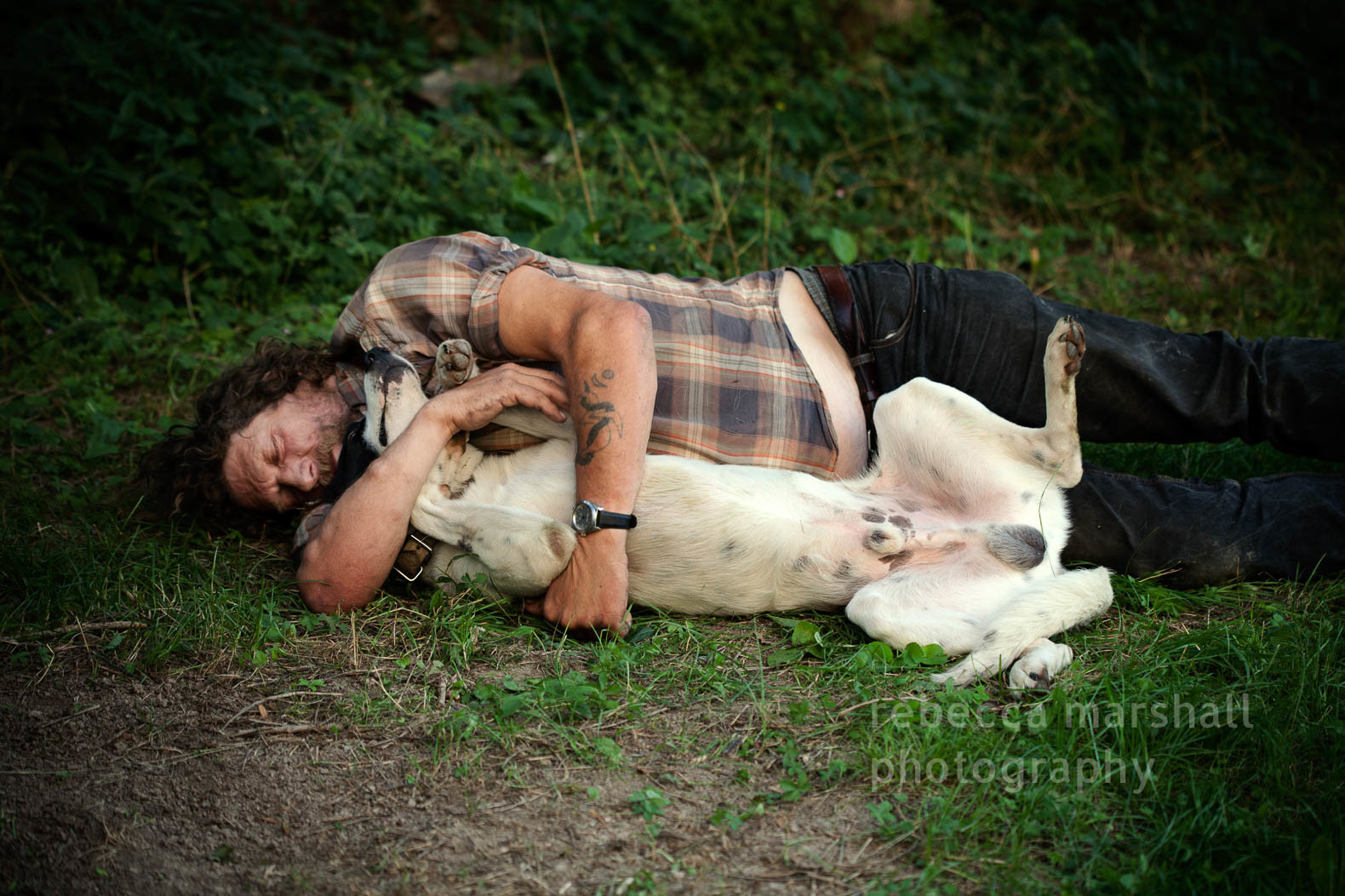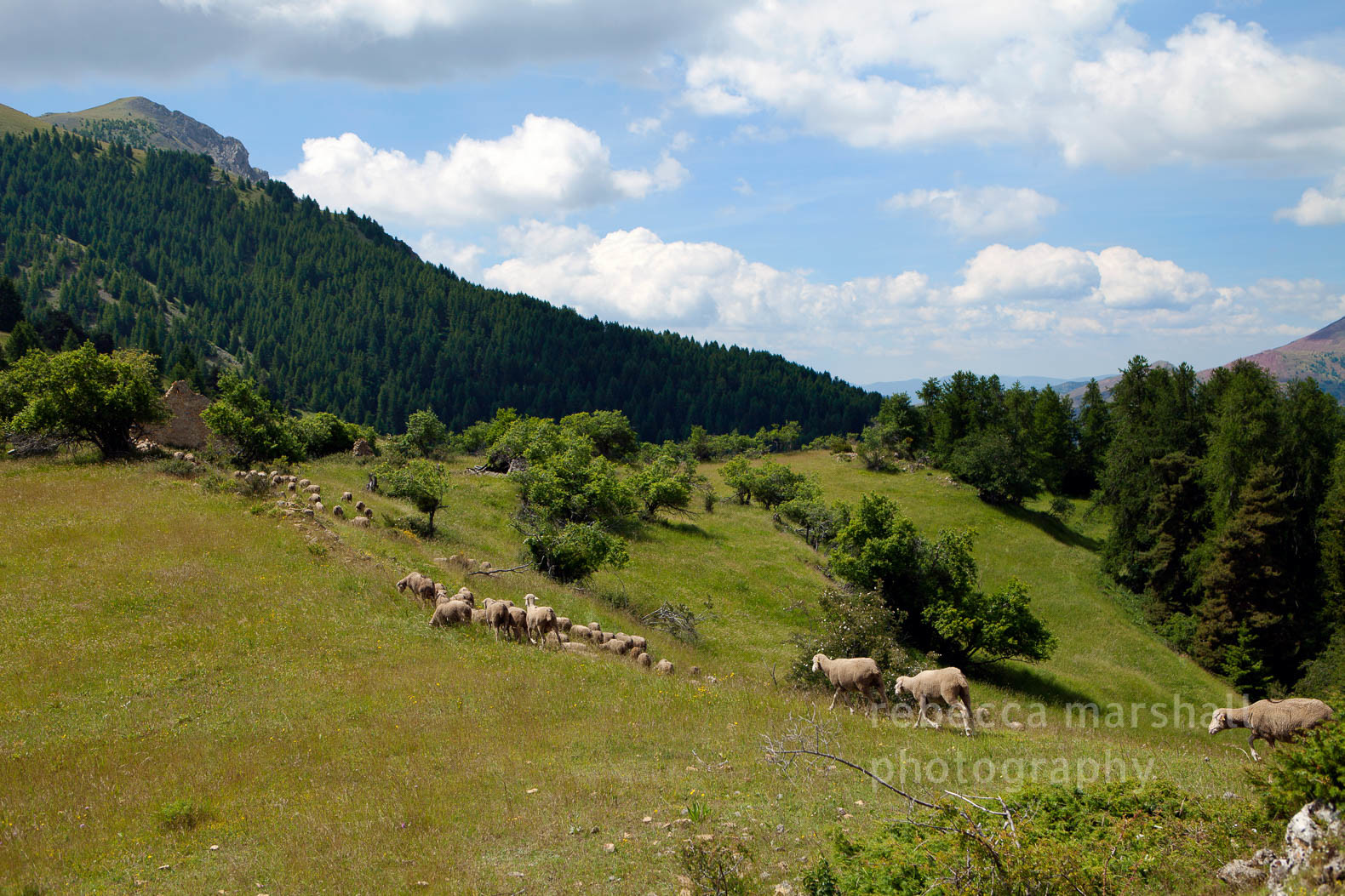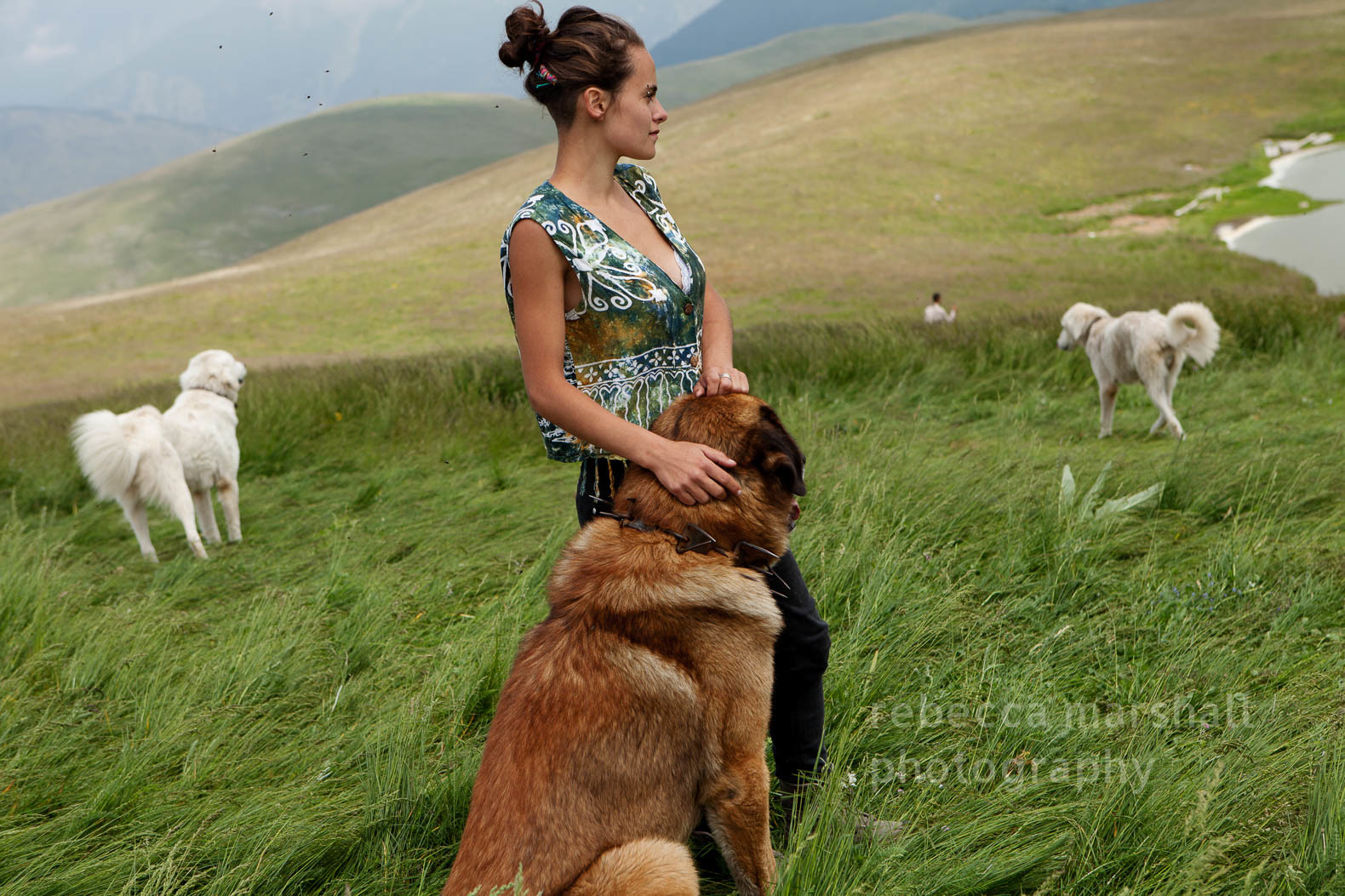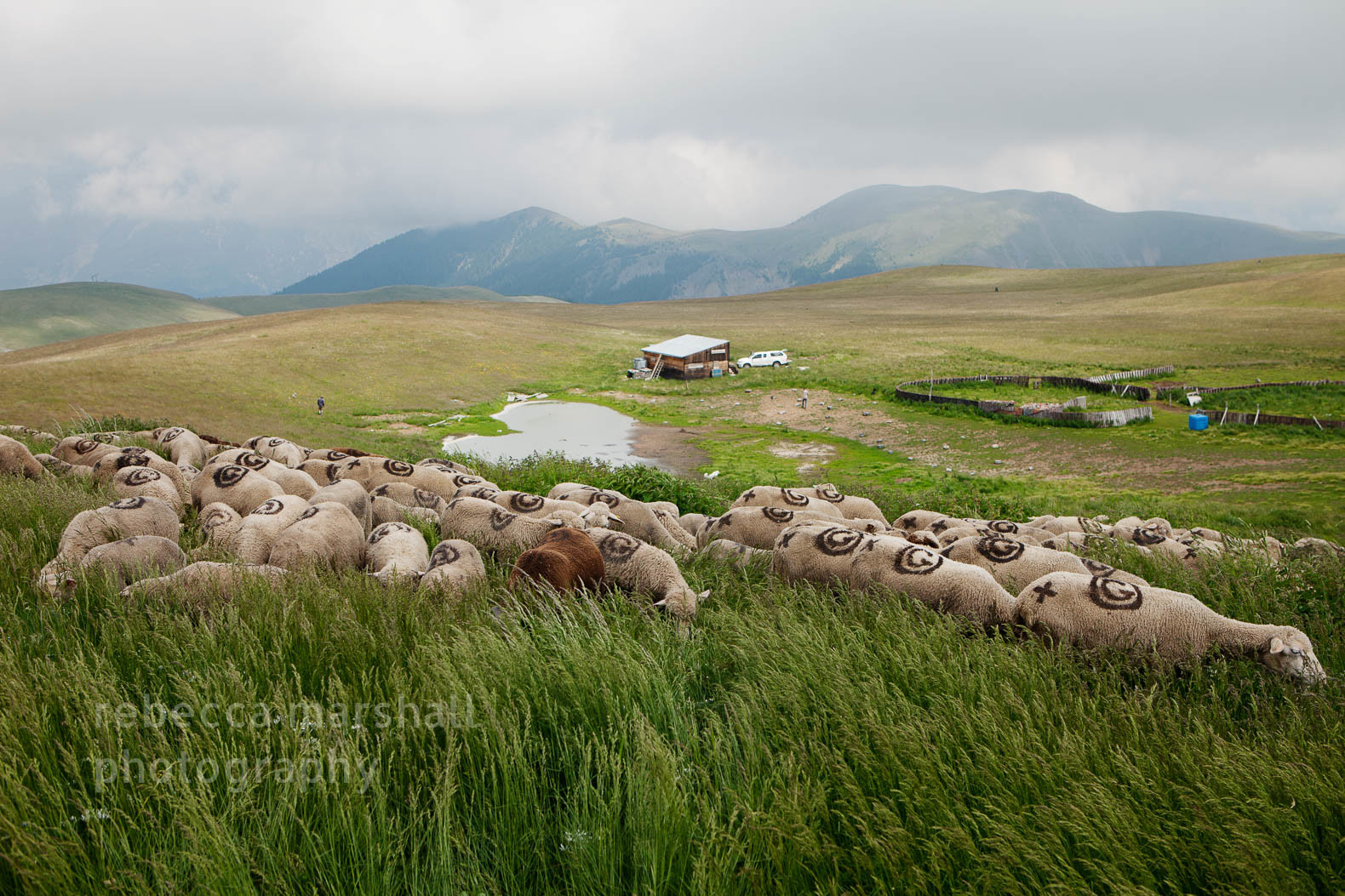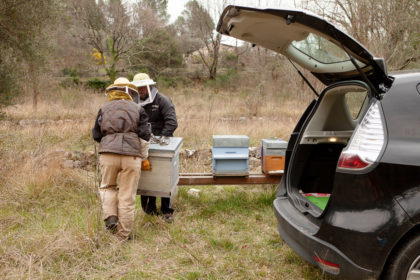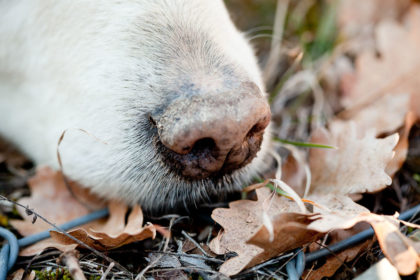Ca y’est. Summer is well and truly under way in the South of France. Along the sweltering Côte d’Azur, people loll around in pools or cool off in the waters of the Mediterranean, sales of gelati go through the roof and ice cubes become an essential addition to a glass of pastis or rosé. But inland, high above the French Riviera, sheep farmers have another solution to the heat for their woolly charges. A few weeks ago, in anticipation of summer, flocks of sheep were moved across Provence from lowland farms up to high mountain altitudes in the French Alps during the annual transhumance. Transhumance, the seasonal moving of livestock from one grazing ground to another, has been a South of France tradition for over 2,000 years. Sheep – and their shepherds – get to spend summer where the air is cooler (and the grass actually IS greener). Last year, I packed as light a photographer’s bag as I could and joined organic sheep farmer Jean-Philippe Girod, his shepherds, family and flock in this ritual migration: a rather extraordinary trip of 3 days and nights.
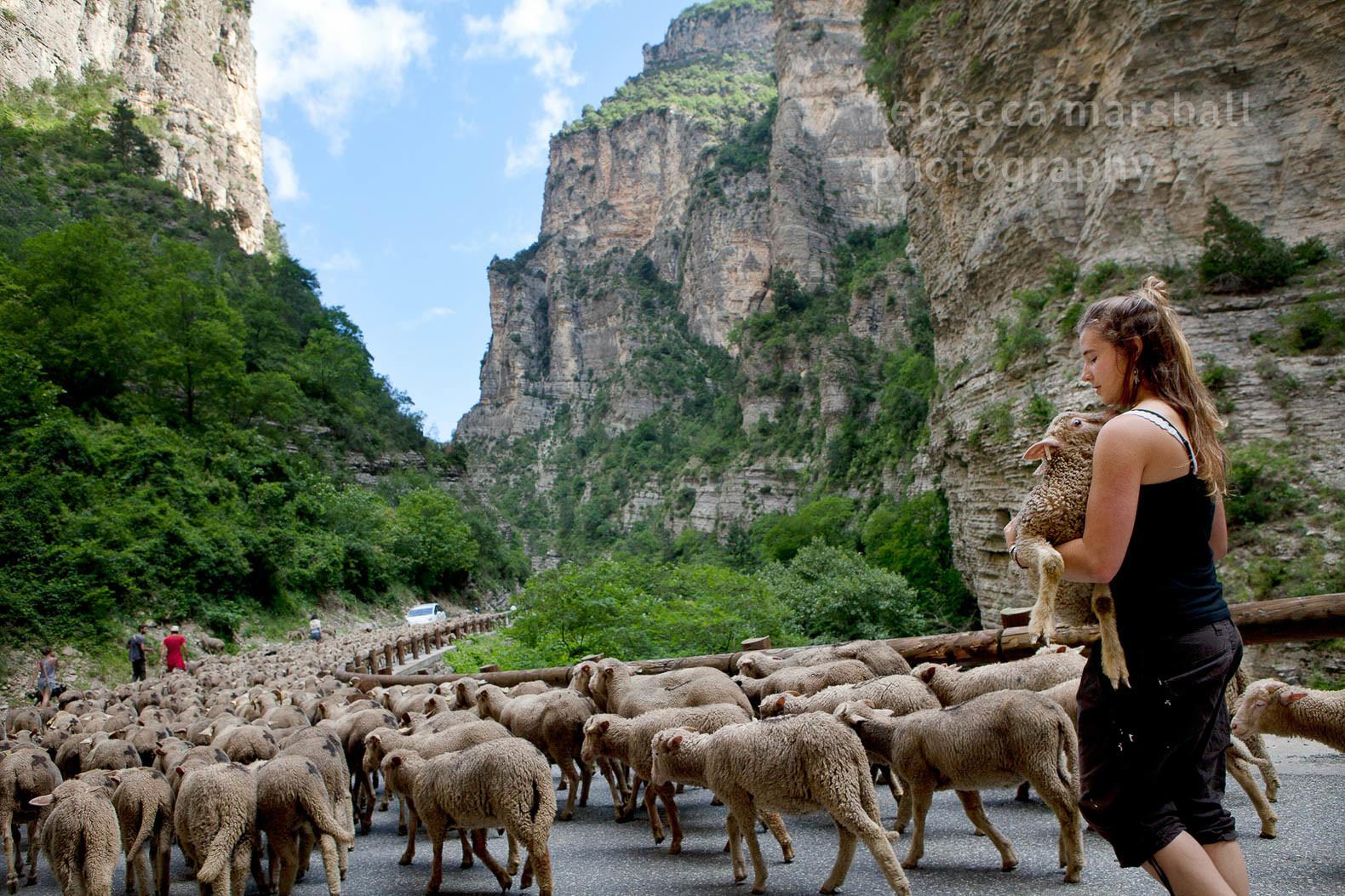
Like a shepherd he tends his flock; he gathers up the lambs with his arm; he carries them close to his heart.
Ancient tracks
Today, most flocks are transported to their summer pastures by lorry. However, this method is not without its risks to the sheep (who can die from the shock of a sudden drop in air temperature when they arrive) and the costs of road transport can be prohibitive. So for these reasons, and out of respect for tradition and for the ecological importance of the passage of sheep to the land, a few sheep farmers still stolidly do their transhumance on foot, just as their ancestors did.
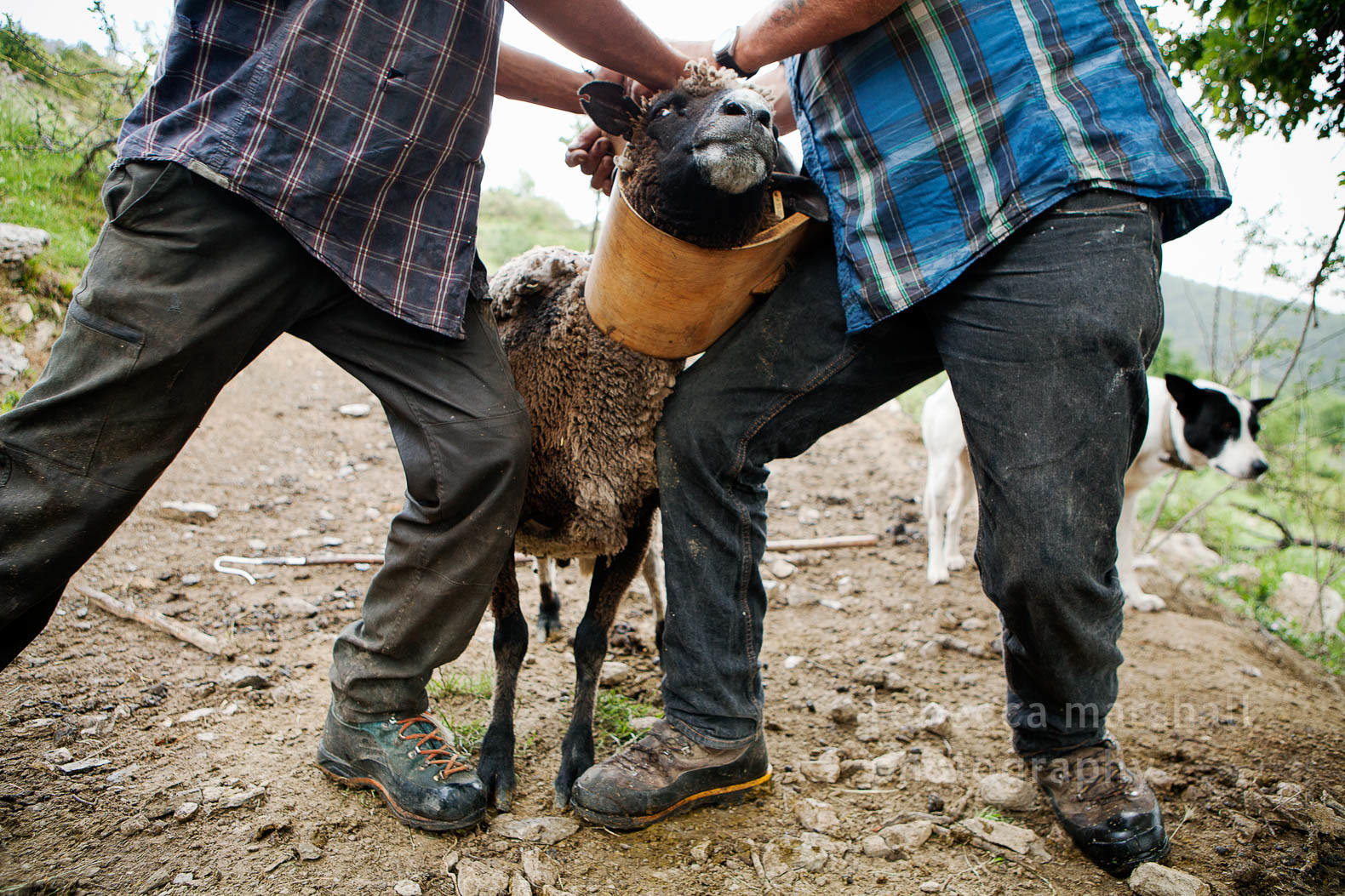
A wether who has been selected and raised as a bell carrier for one of the biggest transhumance bells appears slightly reluctant to assume this honour
A number of lucky sheep are kitted out with a ceremonial transhumance bell. The bells, of different tones, weights and degrees of decoration, warn the inhabitants of villages along the way of the flock’s arrival and alert the shepherd to any breakaway rebel sheep. Their unique harmony and the constant bleating of ewes and lambs trying to locate each other create the soundtrack to an otherwise silent journey. At times, the only signs we are in the 21st century are the occasional mobile phone calls passed between shepherds, who co-ordinate the passing of each others’ flocks to avoid the possibility of them meeting and getting mixed up along the network of ancient sunken roads and hidden mountain tracks that make up the transhumance trail.
Marshmallows, music and 4 a.m. start
Jean-Philippe’s transhumance is considered a relatively short one at only 30 km (they can be much longer, lasting up to 2 weeks). Nevertheless, going at the pace of 600 sheep, several goats and 8 dogs doesn’t make for speedy progress. We walked only during the cooler hours of the day for the sheeps’ wellbeing and started out before dawn each morning, armed with torches and fluorescent jackets. The phrase ‘to beat the traffic’ certainly acquired a new sense of urgency as we filled our unavoidable stretches of road with a tide of hundreds of sheep, who aren’t famed for their road sense.
Our little gathering of shepherds, family, friends and photographer drove the flock forward, stopped enterprising sheep from obliterating village gardens, carried lambs too small to keep up and, when traffic was encountered, ran up & down alongside the flock with long whips to move the sheep to the side of the road. Much to my surprise, the one job that wasn’t apparently needed was someone to lead the way. Many of the older sheep had done the trip several years running and they clearly knew where they were going. In as much as a sheep can look excited, they did: I caught some of the ewes gambolling like lambs.
We walked until after sunset on the first day, then set up camp at a rocky bluff, where the ravine below and cliff face above meant the sheep had nowhere to go. As the fire got going, villagers from the valley below appeared out of the darkness, bearing gifts of food and drink for the evening of feasting that traditionally marks the start of summer here. Merguez [spicy sausages] made from the Girod lambs, their organic cheese, marshmallows roasting in the flames and a plum liqueur that someone’s uncle had brewed, fuelled a jovial night of accordion-accompanied singing and laughter that lasted into the early hours, the sheep passively dozing in the shadows alongside. Sparks from the fire and fireflies mingled in the darkness as, one by one, people melted away to settle down to sleep ‘à la belle étoile‘ [out in the open].
Perils of being a photographer
Wherever there is a flock of sheep in this corner of southeast France, there are likely to be a few ‘patous‘ nearby. These dogs are kept by farmers for one reason only: to protect the sheep from wolves (see an earlier post about France’s wolf problem here). Huge, imposing dogs, they may be of various mountain breeds but the local strain is white and shaggy. Brought up with sheep from birth, they have as little contact with humans as possible and are essentially untrained; their primal instinct is simply to protect their family from any threat, be that from a wolf or a labrador on a walking holiday. One of Girod’s patous killed a pet dog last summer on a public hiking route. The hiker, bent on punishing the farmer, was astonished to discover that mountain rules apply: the patous are protected by law.
In any case, when I arrived at the farm to start the reportage, I wasn’t prepared for the fact that the ‘patous‘ would see a photographer as a mortal threat to their sheep. Baloo, the impressive, waist-high leader of the pack, came at me like a bullet from a gun, her hackles up high around her spiked collar (to prevent wolves ripping out her throat) and spitting rage. Fortunately, as I stood frozen, the shepherd on a hill nearby saw what was happening and yelled loudly, just as she rose onto her haunches and aimed her snarling teeth towards my neck (or was it my camera?). This checked her just enough for me to manage to slowly back away and exit the field with my neck and photography equipment intact (it was not my first narrow escape from being a photographer attacked in the face by a dog – see my post on truffle dogs…)
The transhumance itself posed other challenges. Getting ahead of the sheep for a wide landscape shot involved firstly the challenge of moving up through the flock without causing a wave of ovine panic, then jogging ahead, uphill, with my kit bag. Photographing the flock from behind entailed the same exercise to catch up. I pretty quickly gave up brushing away the million flies and got used to the ever-present smell of sheep poo. But it was a great relief, arriving at camp on the second day, to follow the shepherdesses down to the river below. We stripped off and plunged into the fast-flowing, icy water, delighted to cool our blistered feet and wash away the dirt.
The end of the road
As we walked and walked, lambs were born and one sheep died. As life unfolded before our eyes, so too the landscape changed. From rocky scrub, into woodlands, we climbed up through the spectacular red rock of the Gorges du Cians and dense pine forest on mountain slopes, before finally emerging out above the treeline into Alpine pastures. As we arrived on the third day, tired and hot, I could sense the sheep’s delight. The pace dropped even slower, as the flock spread out across the paradise of luscious grass, herbs and flowers at our feet.
On the summit of the mountain, at the very end of our path, was a little wooden cabin. An hour and a half’s walk from the nearest road (even further from mains electricity and running water), the earth-floored shack had few home comforts and many oversubscribed fly papers hanging from the roof. The transhumance herders arrived in silence, found a crate to sit on and cut a slice of saucisson, or headed to the flea-ridden, stained mattresses in the loft and collapsed. A sense of finality and sadness hung in the air, or so it seemed to me, as all but shepherd Menelik (who was to stay alone and look after the sheep there for the next 4 months) waited for the Land-rover to arrive and drag us back down to civilisation below.
A few days later, back on the French Riviera and no longer smelling of sheep poo, the transhumance seemed a long way away indeed. On assignment as a corporate photographer in Cannes, I was photographing an event. Preparing my first set-up shots, I was horrified to see my main camera displaying an error message and refusing to take a picture. It wasn’t until a few minutes of panic later and a call to Canon that I took the lens off and saw, wedged into the electronic contacts, a grass seed-head. I took it out and smiled as, in the midst of the corporate world of a Cannes trade fair, memories of the transhumance came flooding back.
